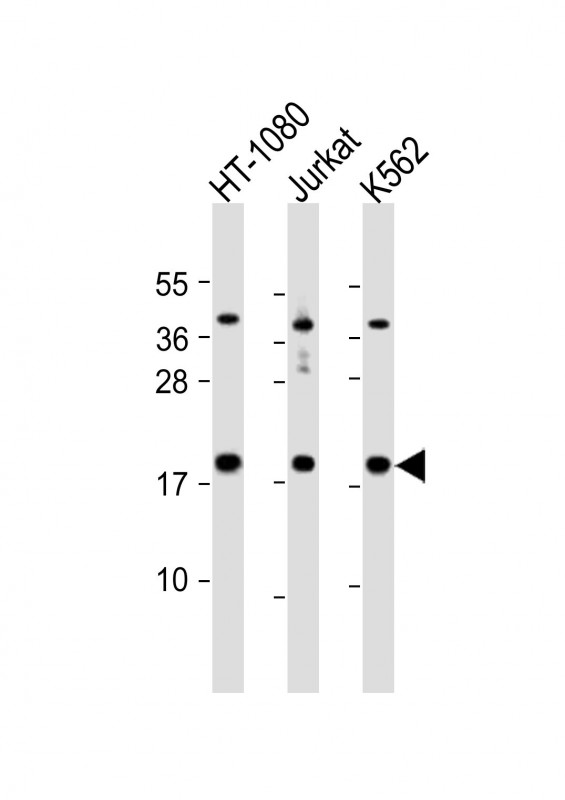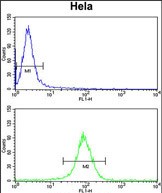NAT13 Antibody (C-term)
Affinity Purified Rabbit Polyclonal Antibody (Pab)
- 产品详情
- 实验流程
- 背景知识
Application
| FC, WB, E |
|---|---|
| Primary Accession | Q9GZZ1 |
| Other Accession | Q6GP53, Q6PGB6, Q6DBY2, Q0IIJ0 |
| Reactivity | Human |
| Predicted | Bovine, Zebrafish, Mouse, Xenopus |
| Host | Rabbit |
| Clonality | Polyclonal |
| Isotype | Rabbit IgG |
| Calculated MW | 19398 Da |
| Antigen Region | 117-146 aa |
| Gene ID | 80218 |
|---|---|
| Other Names | N-alpha-acetyltransferase 50, 231-, N-acetyltransferase 13, N-acetyltransferase 5, hNAT5, N-acetyltransferase san homolog, hSAN, NatE catalytic subunit, NAA50, MAK3, NAT13, NAT5 |
| Target/Specificity | This NAT13 antibody is generated from rabbits immunized with a KLH conjugated synthetic peptide between 117-146 amino acids from the C-terminal region of human NAT13. |
| Dilution | FC~~1:10~50 WB~~1:1000 E~~Use at an assay dependent concentration. |
| Format | Purified polyclonal antibody supplied in PBS with 0.09% (W/V) sodium azide. This antibody is purified through a protein A column, followed by peptide affinity purification. |
| Storage | Maintain refrigerated at 2-8°C for up to 2 weeks. For long term storage store at -20°C in small aliquots to prevent freeze-thaw cycles. |
| Precautions | NAT13 Antibody (C-term) is for research use only and not for use in diagnostic or therapeutic procedures. |
| Name | NAA50 (HGNC:29533) |
|---|---|
| Function | N-alpha-acetyltransferase that acetylates the N-terminus of proteins that retain their initiating methionine (PubMed:19744929, PubMed:21900231, PubMed:22311970, PubMed:27484799). Has a broad substrate specificity: able to acetylate the initiator methionine of most peptides, except for those with a proline in second position (PubMed:27484799). Also displays N-epsilon-acetyltransferase activity by mediating acetylation of the side chain of specific lysines on proteins (PubMed:19744929). Autoacetylates in vivo (PubMed:19744929). The relevance of N-epsilon-acetyltransferase activity is however unclear: able to acetylate H4 in vitro, but this result has not been confirmed in vivo (PubMed:19744929). Component of N-alpha- acetyltransferase complexes containing NAA10 and NAA15, which has N- alpha-acetyltransferase activity (PubMed:16507339, PubMed:27484799, PubMed:29754825, PubMed:32042062). Does not influence the acetyltransferase activity of NAA10 (PubMed:16507339, PubMed:27484799). However, it negatively regulates the N-alpha-acetyltransferase activity of the N-terminal acetyltransferase A complex (also called the NatA complex) (PubMed:32042062). The multiprotein complexes probably constitute the major contributor for N-terminal acetylation at the ribosome exit tunnel, with NAA10 acetylating all amino termini that are devoid of methionine and NAA50 acetylating other peptides (PubMed:16507339, PubMed:27484799). Required for sister chromatid cohesion during mitosis by promoting binding of CDCA5/sororin to cohesin: may act by counteracting the function of NAA10 (PubMed:17502424, PubMed:27422821). |
| Cellular Location | Cytoplasm. Nucleus Note=Localizes to the cytoplasm in interphase cells (PubMed:17502424) |
Research Areas
For Research Use Only. Not For Use In Diagnostic Procedures.
Application Protocols
Provided below are standard protocols that you may find useful for product applications.
BACKGROUND
NAT13 is probable catalytic component of the ARD1A-NARG1 complex which displays alpha (N-terminal) acetyltransferase activity.
REFERENCES
Starheim, K.K., et al. Mol. Cell. Biol. 29(13):3569-3581(2009)
Polevoda, B., et al. BMC Proc 3 SUPPL 6, S2 (2009)
Hou, F., et al. J. Cell Biol. 177(4):587-597(2007)
终于等到您。ABCEPTA(百远生物)抗体产品。
点击下方“我要评价 ”按钮提交您的反馈信息,您的反馈和评价是我们最宝贵的财富之一,
我们将在1-3个工作日内处理您的反馈信息。
如有疑问,联系:0512-88856768 tech-china@abcepta.com.























 癌症的基本特征包括细胞增殖、血管生成、迁移、凋亡逃避机制和细胞永生等。找到癌症发生过程中这些通路的关键标记物和对应的抗体用于检测至关重要。
癌症的基本特征包括细胞增殖、血管生成、迁移、凋亡逃避机制和细胞永生等。找到癌症发生过程中这些通路的关键标记物和对应的抗体用于检测至关重要。 为您推荐一个泛素化位点预测神器——泛素化分析工具,可以为您的蛋白的泛素化位点作出预测和评分。
为您推荐一个泛素化位点预测神器——泛素化分析工具,可以为您的蛋白的泛素化位点作出预测和评分。 细胞自噬受体图形绘图工具为你的蛋白的细胞受体结合位点作出预测和评分,识别结合到自噬通路中的蛋白是非常重要的,便于让我们理解自噬在正常生理、病理过程中的作用,如发育、细胞分化、神经退化性疾病、压力条件下、感染和癌症。
细胞自噬受体图形绘图工具为你的蛋白的细胞受体结合位点作出预测和评分,识别结合到自噬通路中的蛋白是非常重要的,便于让我们理解自噬在正常生理、病理过程中的作用,如发育、细胞分化、神经退化性疾病、压力条件下、感染和癌症。







